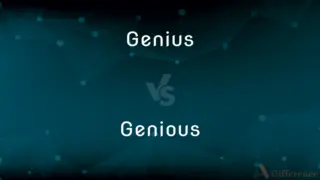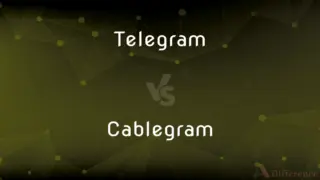Vowels vs. Consonants — What's the Difference?
By Tayyaba Rehman — Published on October 17, 2023
Vowels and Consonants are both types of letters in the alphabet. Vowels include the letters A, E, I, O, U, and sometimes Y, while Consonants are all the other letters that are not vowels.

Difference Between Vowels and Consonants
Table of Contents
ADVERTISEMENT
Key Differences
In written English, both Vowels and Consonants are essential for creating meaning. They come together to form syllables, words, and sentences. Vowels often carry the tonal quality of a word, while Consonants provide the structure and rhythm.
Tayyaba Rehman
Oct 17, 2023
Vowels and Consonants serve as foundational building blocks of words in the English language. A word in English cannot exist without a vowel, whereas words without consonants do exist. Vowels create the vocal sounds that resonate, while Consonants provide closures or constrictions of vocal tracts.
Tayyaba Rehman
Oct 17, 2023
Vowels offer more vocal variation than Consonants. Each vowel can be pronounced in a short or long manner, giving a word its specific sound. Consonants, conversely, typically have one specific sound that doesn't change based on the word's context, although there are exceptions like the soft "c" in "city" versus the hard "c" in "cat".
Tayyaba Rehman
Oct 17, 2023
Phonetically speaking, Vowels are voiced sounds made without significant constriction of airflow in the mouth. Consonants involve a greater obstruction of the oral passage, often using the lips, teeth, or tongue. For instance, the "b" sound in "bat" is formed by briefly blocking airflow with the lips.
Tayyaba Rehman
Oct 17, 2023
The English language recognizes A, E, I, O, U, and occasionally Y as Vowels. They can stand alone and be a word on their own, like "a" or "I". On the other hand, Consonants are letters that are not vowels, and they require a vowel to form a syllable. Examples of Consonants include letters like B, C, D, F, and G.
Tayyaba Rehman
Oct 17, 2023
ADVERTISEMENT
Comparison Chart
Letters in English
A, E, I, O, U, sometimes Y
All other letters not listed as vowels
Tayyaba Rehman
Oct 17, 2023
Role in Words
Can form a word by themselves
Typically require a vowel to form a syllable
Tayyaba Rehman
Oct 17, 2023
Phonetic Nature
No significant constriction of airflow
Constriction using lips, teeth, or tongue
Tayyaba Rehman
Oct 17, 2023
Variation in Sound
Can have short or long sounds
Typically one sound, some exceptions exist
Tayyaba Rehman
Oct 17, 2023
Existence in Words
Words must have at least one vowel
Words can exist without consonants
Tayyaba Rehman
Oct 17, 2023
ADVERTISEMENT
Definitions
Vowels
Letters in the alphabet that represent open sounds without constriction.
A and e.
Tayyaba Rehman
Oct 04, 2023
Consonants
Sounds in speech produced by a closure or constriction of the vocal tract.
The first sound in chat is made by a Consonant, ch.
Tayyaba Rehman
Oct 04, 2023
Vowels
Vocal sounds that form the nucleus of syllables in words.
Every word in English must contain at least one of the Vowels.
Tayyaba Rehman
Oct 04, 2023
Consonants
The structure-giving sounds in words that often determine the word's rhythm.
Consonants give the word stretched its unique rhythm and sound.
Tayyaba Rehman
Oct 04, 2023
Vowels
The resonant sounds in a language that can create tonal variations in words.
The Vowels in mate and mat give the words different meanings.
Tayyaba Rehman
Oct 04, 2023
Consonants
Letters that typically need a vowel to form a syllable or word.
The Consonants in grab are g, r, and b.
Tayyaba Rehman
Oct 04, 2023
Vowels
Sounds produced without any significant closure in the oral cavity.
The word eye has a long vowel sound.
Tayyaba Rehman
Oct 04, 2023
Consonants
Any letter that is not A, E, I, O, U, or sometimes Y in English.
P, Q, and R are all Consonants in the English language.
Tayyaba Rehman
Oct 04, 2023
Vowels
The letters A, E, I, O, U, and occasionally Y in the English language.
U is the last of the primary Vowels in the English alphabet.
Tayyaba Rehman
Oct 04, 2023
Consonants
Letters in the English alphabet that are not vowels.
B, C, and D are examples of Consonants.
Tayyaba Rehman
Oct 04, 2023
Vowels
A speech sound, such as (ē) or (ĭ), created by the relatively free passage of breath through the larynx and oral cavity, usually forming the most prominent and central sound of a syllable.
Tayyaba Rehman
Oct 01, 2023
Consonants
Being in agreement or accord
Remarks consonant with our own beliefs.
Tayyaba Rehman
Oct 01, 2023
Vowels
A letter, such as a, e, i, o, u, and sometimes y in the English alphabet, that represents a vowel.
Tayyaba Rehman
Oct 01, 2023
Consonants
A speech sound produced by a partial or complete obstruction of the air stream by any of various constrictions of the speech organs, such as (p), (f), (r), (w), and (h).
Tayyaba Rehman
Oct 01, 2023
FAQs
Which letters are considered Consonants?
Any letter that is not a vowel is a Consonant.
Tayyaba Rehman
Oct 17, 2023
Can a word exist without Vowels?
No, every English word must have at least one vowel.
Tayyaba Rehman
Oct 17, 2023
Do Consonants always sound the same?
Mostly, but some have multiple sounds, like "c" in "cat" and "city."
Tayyaba Rehman
Oct 17, 2023
What are the main Vowels in English?
The main Vowels are A, E, I, O, and U.
Tayyaba Rehman
Oct 17, 2023
Are there words without Consonants?
Yes, words like "a," "I," and "ooh" don't have Consonants.
Tayyaba Rehman
Oct 17, 2023
How are Vowels pronounced?
Vowels are pronounced without significant constriction of airflow.
Tayyaba Rehman
Oct 17, 2023
Can Y be considered a vowel?
Yes, in certain words like "cry" or "gym," Y acts as a Vowel.
Tayyaba Rehman
Oct 17, 2023
Why are Vowels important in words?
Vowels often determine the tone and meaning of words.
Tayyaba Rehman
Oct 17, 2023
Are there more Vowels or Consonants in English?
There are more Consonants than Vowels in the English alphabet.
Tayyaba Rehman
Oct 17, 2023
Author Spotlight
Written by
Tayyaba RehmanTayyaba Rehman is a distinguished writer, currently serving as a primary contributor to askdifference.com. As a researcher in semantics and etymology, Tayyaba's passion for the complexity of languages and their distinctions has found a perfect home on the platform. Tayyaba delves into the intricacies of language, distinguishing between commonly confused words and phrases, thereby providing clarity for readers worldwide.

















































